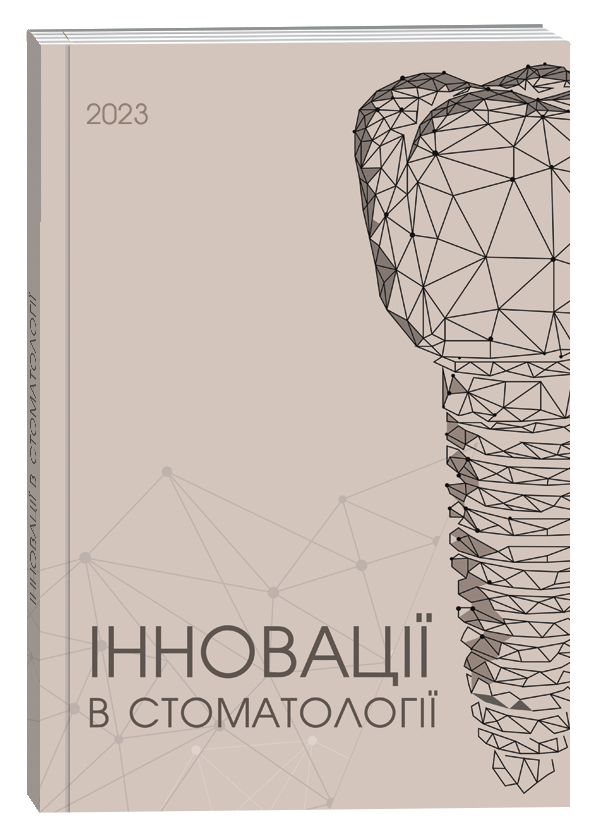ANALYSIS OF THE CLINICAL CONDITION OF TOOTH RESTORATIONS WITH PHOTOCOMPOSITE MATERIALS
DOI:
https://doi.org/10.35220/2523-420X/2025.1.4Keywords:
posterior teeth, direct restoration, retrospective assessment, clinical condition, defects, composite materialsAbstract
Objective. Retrospective clinical assessment of the condition of direct composite restorations of posterior teeth. Materials and Methods. In 139 patients, 627 direct composite restorations of posterior teeth were examined, including 229 restorations (36.5 %) on the occlusal surface and 398 restorations (64.5 %) on the occlusal and one of the contact surfaces. The restorations were evaluated using adapted criteria for each surface and for the cervical area of the contact surface. Results. With localization exclusively on the occlusal surface, 27 restorations (11.8 %) had marginal adaptation defects, 22 restorations (9.6 %) had marginal discoloration, 4 restorations (1.7 %) had anatomical form defects, secondary caries was detected in 9 restored teeth (3.9 %), and wall fractures were found in 3 cases (1.3 %). For restorations located on the occlusal and one of the contact surfaces of the teeth, defects on the occlusal surface alone included marginal adaptation defects in 42 restorations (10.6 %), marginal discoloration in 39 restorations (9.8 %), and secondary caries in 14 restored teeth (3.5 %). On the vestibular and oral surfaces, 37 restorations (9.2 %) had marginal adaptation defects, 35 restorations (8.8 %) had marginal discoloration, and secondary caries was detected in 16 restored teeth (4 %). Anatomical form defects with violation of the contact point were found in 46 restorations (11.6 %), along with 61 cases (15.2 %) of non-functional contact points, totaling 107 cases (26.8 %) of contact point defects. Wall fractures were identified in 23 teeth (5.8 %), and cracks in 2 restorations (0.5 %). In the cervical area of the contact surface, marginal adaptation defects were found in 92 restorations (23.1 %), and secondary caries in 84 restored teeth (21.1 %). On all surfaces of restorations located on the occlusal and one of the contact surfaces, marginal adaptation defects were observed in 171 restorations (43 %), and secondary caries in 114 restored teeth (28.6 %).Conclusions. A significant number of defects in restorations on the occlusal and one of the contact surfaces of posterior teeth indicates the necessity of strict adherence to the technique of direct restoration and the need for frequent follow-up examinations.
References
Попович І. Ю., Петрушанко Т. О. Клінічна ефективність прямої реставрації девітальних фронтальних зубів із використанням внутрішньоканальних штифтів. Актуальні проблеми сучасної медицини. Вісник Української медичної стоматологічної академії. 2014. Т. 14, № 4. С. 36–37.
Alzraikat H., Burrow M. F., Maghaireh G. A., Taha N.A. Nanofilled resin composite properties and clinical performance: a review. Oper. Dent. 2018. Vol. 43, № 4. P. E173–E190. DOI: 10.2341/17-208-T
Schwendicke F., Göstemeyer G., Blunck U., Paris S., Hsu L. Y., Tu Y. K. Directly placed restorative materials: review and network meta-analysis. J. Dent. Res. 2016. Vol. 95, № 6. P. 613–622. DOI: 10.1177/0022034516631285
Sharan J., Singh S., Lale S. V., Mishra M., Koul V., Kharbanda P. Applications of nanomaterials in dental science: a review. J. Nanosci. Nanotechnol. 2017. Vol. 17, № 4. P. 2235–2255. DOI: 10.1166/jnn.2017.13885
Kaisarly D., Gezawi M. E. Polymerization shrinkage assessment of dental resin composites: a literature review. Odontology. 2016. Vol. 104, № 3. P. 257–270. DOI: 10.1007/s10266-016-0264-3
Soares C. J., Faria-E-Silva A. L., Rodrigues M. P., VilelaA . B. F., Pfeifer C. S., Tantbirojn D. et al. Polymerization shrinkage stress of composite resins and resin cements – What do we need to know? Braz. Oral Res. 2017. Vol. 31, suppl. 1. Art. e62. DOI: 10.1590/1807-3107BOR-2017.vol31.0062
Wang Z., Chiang M. Y. Correlation between polymerization shrinkage stress and C-factor depends upon cavity compliance. Dent. Mater. 2016. Vol. 32, № 3. P. 343–352. DOI: 10.1016/j.dental.2015.11.003
Rajak D. K., Pagar D. D., Menezes P. L., Linul E. Fiber-reinforced polymer composites: manufacturing, properties, and applications. Polymers (Basel). 2019. Vol. 11, № 10. Art. 1667. DOI: 10.3390/polym11101667
Raghu R., Srinivasan R. Optimizing tooth form with direct posterior composite restorations. J. Conserv. Dent. 2011. Vol. 14, № 4. P. 330–336. DOI: 10.4103/0972-0707.87192
Удод О. А., Борисенко О. М. Стан фотокомпозиційних відновлень зубів у різних умовах світлової полімеризації адгезивної системи. Український стоматологічний альманах. 2019. № 1. С. 16–19.
Удод О. А., Роман О. Б. Удосконалені підходи до прямого відновлення зубів фото композитами. Colloquium-journal. 2020. № 20, ч. 1. С. 16–19. DOI: 10.24411/2520-6990-2020-12071
Decup F., Dantony E., Chevalier C., David A., Garyga V., Tohmé M., Gueyffier F., Nony P., Maucort- Boulch D., Grosgogeat B. Needs for re-intervention on restored teeth in adults: a practice-based study. Clin Oral Investig. 2022. № 26(1). Р. 789–801. doi: 10.1007/ s00784-021-04058-5
Demarco F. F., Corrêa M. B., Cenci M. S., Moraes R. R., Opdam N. J. Longevity of posterior composite restorations: not only a matter of materials. Dent. Mater. 2012. Vol. 28, № 1. P. 87–101. DOI: 10.1016/ j.dental.2011.09.003
Wilson N., Lynch C. D., Brunton P. A., Hickel R., Meyer-Lueckel H., Gurgan S. et al. Criteria for the replacement of restorations: Academy of Operative Dentistry European Section. Oper. Dent. 2016. Vol. 41, suppl. 7. P. S48–S57. DOI: 10.2341/15-058-0
Shu X., Mai Q. Q., Blatz M., Price R., Wang X. D., Zhao K. Direct and indirect restorations for endodontically treated teeth: a systematic review and meta-analysis, IAAD 2017 Consensus Conference Paper. J. Adhes. Dent. 2018. Vol. 20, № 3. P. 183–194. DOI: 10.3290/j.jad.a40762








